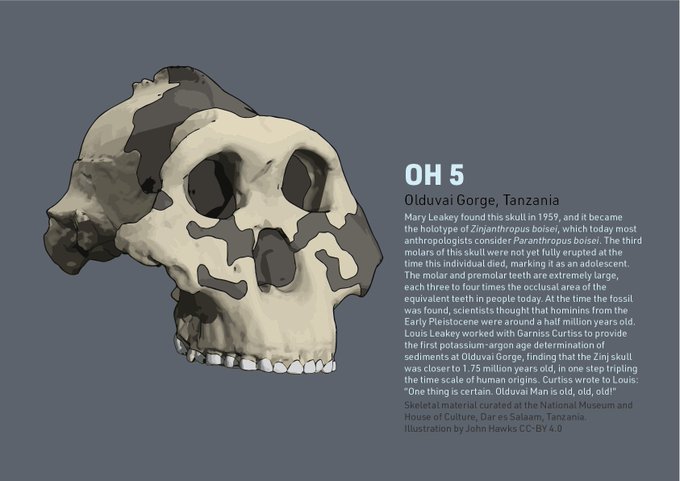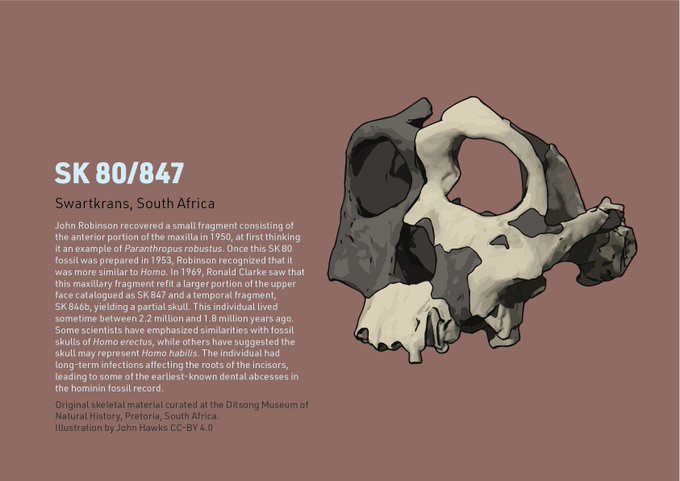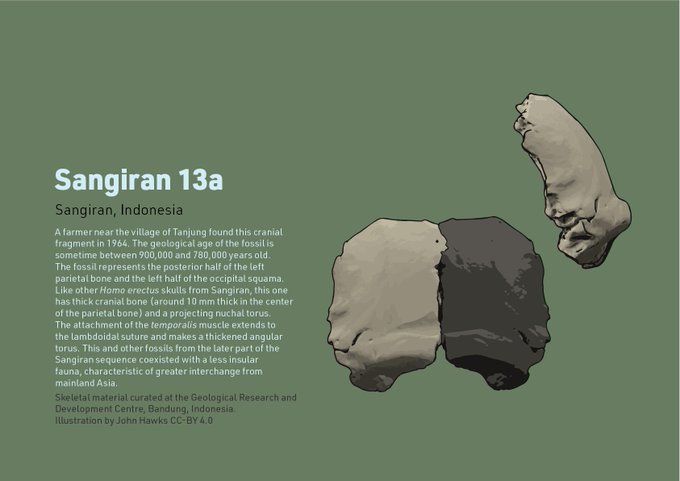paleoanthropologyのTwitterイラスト検索結果。 121 件中 2ページ目
The 1959 discovery of the OH 5 #hominin skull led to the first K-Ar age determination of sediments at Olduvai by Garniss Curtiss. Finding them to be 1.75 Ma—triple the expected age—he wrote: "One thing is certain. Olduvai Man is old, old, old!" #paleoanthropology #FossilFriday
An approximately 1.9-million-year-old #hominin fossil from Swartkrans, South Africa, attributed to the genus Homo is one of the first to have dental abcesses, which affect the tips of its incisor roots. #paleoanthropology
Neanderthal male face in colored pencil...
#neanderthal #prehistoric #paleoanthropology #paleoart #art #ArtistOnTwitter
The most well-preserved evidence of the brain of #Homonaledi comes from the DH3 partial skull. At 450 ml, this #hominin fossil's endocranial volume is around one third the size of the average living human, but shares some aspects of frontal lobe form. #paleoanthropology
Skull 3 from Dmanisi is one of the most complete cranial remains attributed to Homo erectus. This #hominin individual represents a stage of development just before adulthood, with third molars just beginning to erupt. #paleoanthropology
Recent work by Yolanda Fernández-Jalvo and Peter Andrews found that cranial fractures on the Spy 1 Neandertal skull were the likely cause of death of this #hominin individual. A new dating scheme places the Spy Neandertals between 44,300 and 40,700 years ago. #paleoanthropology
Even small fragments of Homo erectus skulls are often very recognizable, due to their thick cranial bone and prominent, thickened entheses. This #hominin skull fragment existed at a time of faunal interchange between Java and mainland Asia. #paleoanthropology
One of the beautiful #hominin fossils found in South Africa during the last few years is the DNH 155 skull, reconstructed by @Palaeozone. This Paranthropus robustus individual lived sometime around 2 million years ago. #paleoanthropology #FossilFriday
Homo antecessor is a species that occupies a fascinating time and place in human origins. The #hominin material from Gran Dolina are the closest known sister group to the common ancestor of today's people, Neandertals, and Denisovans. #paleoanthropology
The most complete skeleton attributed to Australopithecus afarensis is the young child from Dikika, Ethopia. This #hominin had a hyoid bone similar to chimpanzees and gorillas, suggesting apelike vocal communication. #paleoanthropology
The #hominin skull from Hexian, China, is a Homo erectus individual from around 410,000 years ago, who suffered soft tissue injuries to his or her scalp—in today's people consistent with injury from extreme hair pulling or burns. #paleoanthropology
The fossils from Caune de l'Arago, France, are around the same age as the large Sima de los Huesos sample of early Neandertals. Whether they represent the same #hominin population is not clear. They test our ability to determine relationships with morphology. #paleoanthropology
KNM-ER 992 was one of the #hominin fossils discovered by Richard Leakey's field team that were claimed as holotypes for species named by other scientists: in this case Homo ergaster. This "taxonomic scramble" of the 1970s and 1980s left a harmful legacy in #paleoanthropology
The "Ardi" skeleton from Aramis, Ethiopia, provides the most complete cranial, dental, and postcranial evidence of any hominoid from the Early Pliocene. Some of its features point to a relationship with later #hominin remains. #paleoanthropology
The variability of the #hominin fossils from Hadar, Ethiopia, has long been attributed to sexual dimorphism and temporal trends within Australopithecus afarensis. The recent discovery of other species at nearby sites may require re-evaluation of this idea. #paleoanthropology
The MLD 40 #hominin jaw is one of the larger ones attributed to Australopithecus africanus. Raymond Dart thought that it was a victim of cannibalism, but it lacks the evidence that we look for today to identify this behavior. #paleoanthropology
A child's skull from Herto, Ethiopia, appears to document a mortuary practice involving the long-term keeping and handling of human remains, more than 147,000 years ago. Cultural observance of death may go back much further in #hominin ancestry. #paleoanthropology #FossilFriday
Léon Henri-Martin found the humerus of a Neandertal partial skeleton in 1911 at La Quina. He wrote, "The fragility and powdery state of the upper right maxilla made three teeth fall into my hands." #hominin #paleoanthropology
One of the first known mandibles of Homo erectus was this left side of a jaw from Zhoukoudian, China, found in 1931. Many #hominin jaws discovered later would come to be called H. erectus because of similarity to this individual. #paleoanthropology
Textbooks often treat Homo habilis as a common ancestor for all later species in our genus. But the OH 7 mandible shows that this #hominin may have evolved quite differently from other members of Homo. #paleoanthropology





















